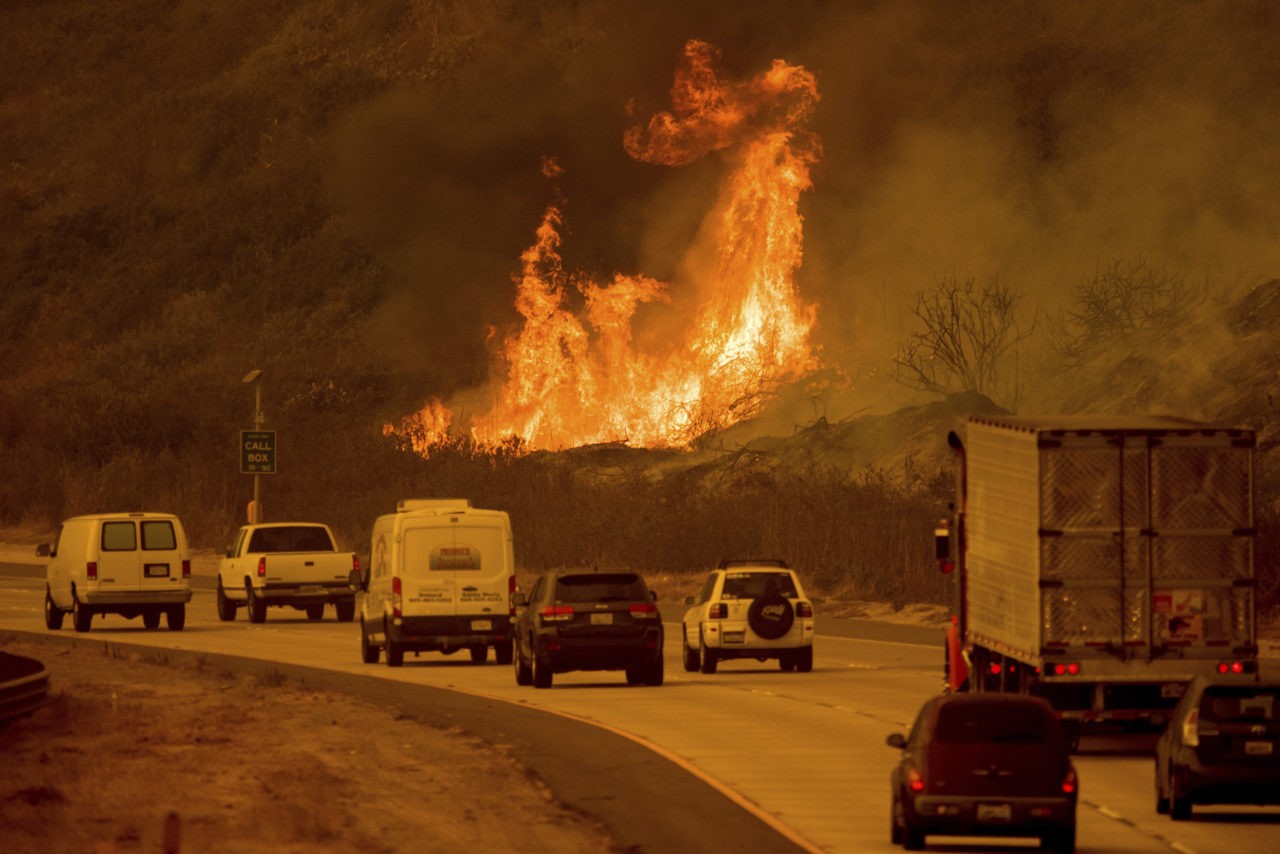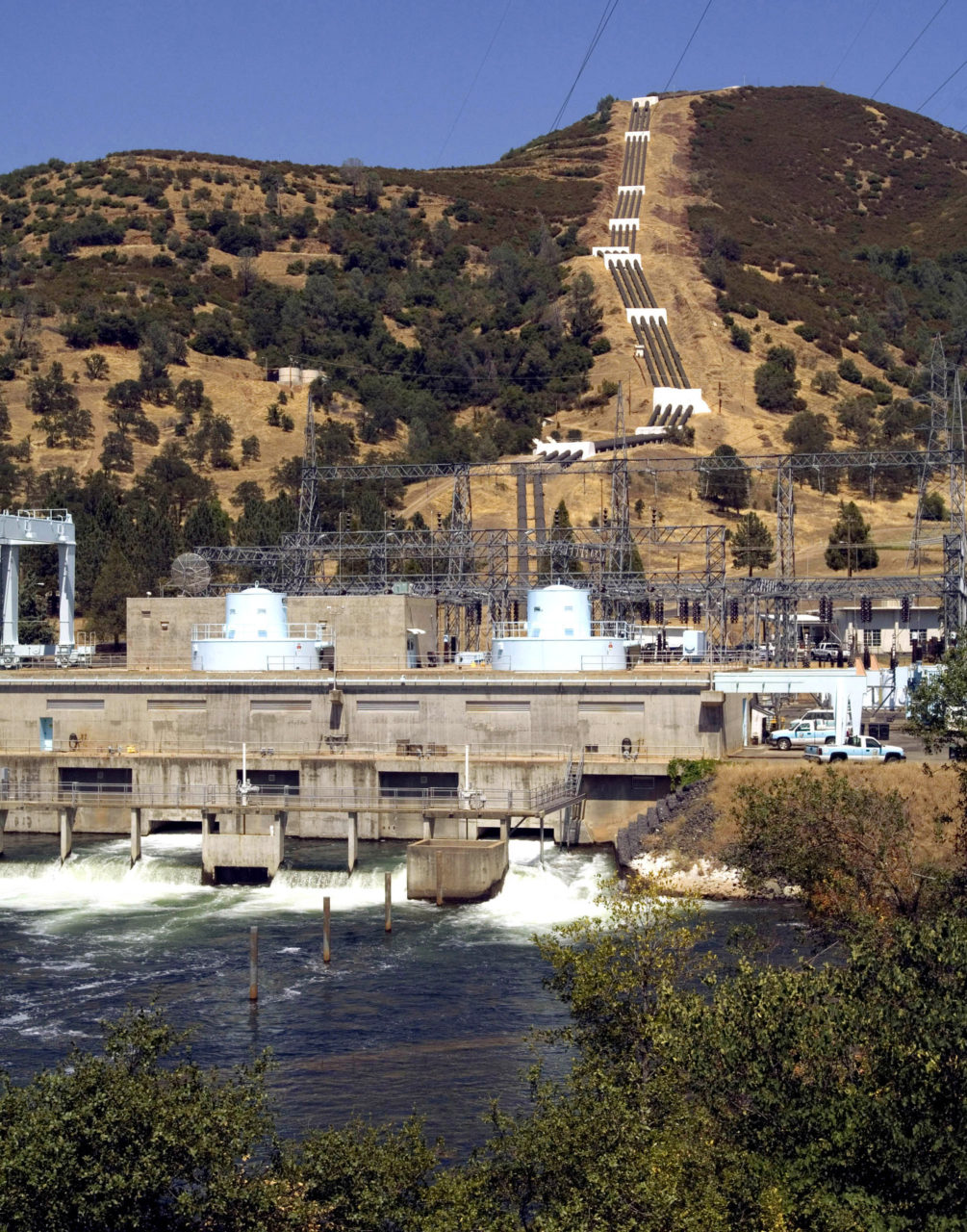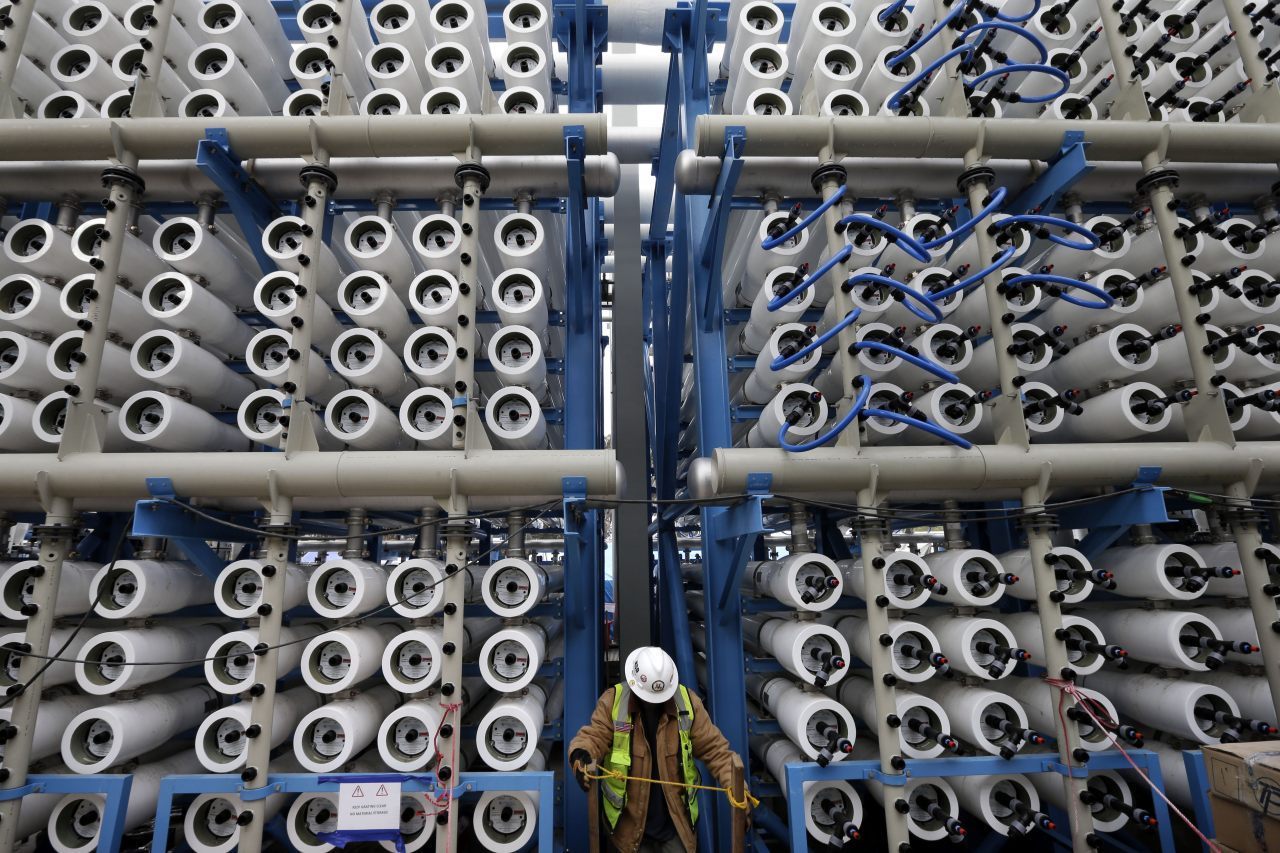
The Fire Last Time, the Fire Next Time
As the 2017 wildfire season in California recedes in time, if not in memory, the 2018 wildfire season is looming into view. And so if you live in the Golden State—now the Scorched State, as more than 500,000 acres were burned in 2017—you should be worried about a fire-haunted future. After all, the several hundred fires that erupted last year killed at least 31 people and devastated or disrupted the lives of millions.
Indeed, AccuWeather estimates that the cost of last year’s California fires will total a staggering $180 billion. That’s almost one percent of the gross domestic product of the entire United States, all 50 states. And if we think, too, about all the other fires across the country, we should recognize that, as the population grows—it’s a little over 327 million now, and growing at about .7 percent a year—we have a deepening national problem. For all Americans, these fires were, and will be, a big deal.
Yet here’s a hopeful—although hypothetical—scenario for the next time, wildfire-wise:
After a dry summer, wildfires erupted in many places across California. Fortunately, the governor was ready; the chief executive ordered the state’s 30 seawater desalination plants, from San Diego in the south to Crescent City in the north, to double their normal output. Billions of gallons of clean, fresh, water from the coastal desalination plants were piped as close as possible to the locations of the fires. From those points, the water was mostly trucked to the actual firefront, where firefighters quickly put out most of the fires; they simply inundated the flames in a watery avalanche—there was so much water, it was almost easy.
In addition, other harder-to-reach fires were doused from the air, as airplanes “bombed” the flames with endless barrages of desalinated water. Moreover, helicopters and blimps used a new technique: They skyhooked flexible plastic water pipelines from where they lay on the ground and then pointed them back down at the fires, like a child aiming a garden hose. The result was that all the fires, statewide, were put out within hours. Damage was minimal.
Okay, so that’s just a hypothetical scenario.
In fact, as things stand now, it’s very hypothetical, because the political class in California doesn’t seem much interested in big and bold solutions to the fire threat. Instead, the focus has been on other issues, including sanctuary cities and high-speed rail.
Yet water should be a higher priority—a much higher priority—because California, by its nature, is dry; it ranks 40th among the states in annual rainfall.

Flames from a wildfire leap above traffic on Highway 101 north of Ventura, CA., on Wednesday, Dec. 6, 2017. (AP Photo/Noah Berger)
The aridity of California was, in fact, the topic of a recent discussion on SiriusXM’s Breitbart News Tonight, as California-based co-hosts Rebecca Mansour and Joel Pollak interviewed John Woolfolk, city editor at the San Jose Mercury News; they compared California’s water predicament to other dry zones around the world. Yes, fresh water is indeed a worldwide problem; in addition to firefighting, it’s a key to agriculture and to all economic growth—as well as, of course, to life itself.
Moreover, historically, the economic advancement of California is proof of the power of water. Back in 1900, the state was home to less than 1.5 million people, most of them barely eking out a living in a pleasant but mostly dusty environment.
Then came the infrastructure visionaries, alive with big ideas about Big Water. In 1913, the projects along the Owens River began delivering water to Southern California. And in 1934, the equally massive Hetch Hetchy Project started sending water to Northern California. Over the course of the 20th century, the state built thousands of pipelines, aqueducts, reservoirs, and other water facilities. It was a big investment, for sure, but the investment paid off many times over.

The Hetch Hetchy water system in Yosemite National Park, CA. (AP Photo/Al Golub, File)
Interestingly, back in the day, the Democrats, as the avowedly forward-looking party of New Deal-type public works, declared themselves to be the leading champions of water development. In the Democratic campaign platform of 1960, for example, we see this bit of hydro one-upmanship:
We will support and intensify the research effort to find an economical way to convert salt and brackish water. The Republicans discouraged this research, which holds untold possibilities for the whole world.
The Democrats, led by John F. Kennedy, won the election that year. Indeed, in the White House, JFK spoke frequently about the gains that could come from turning “unused resources” into wealth-producing assets.
Interestingly, in that same era, California governor Pat Brown, who served from 1959-1967, was always a staunch advocate of water development.
By contrast, his son, the current governor, Jerry Brown, has been, shall we say, less staunch. In fact, since the 1970s—around the time that Jerry Brown became California’s governor for the first time, in 1975, preaching about the “era of limits”—the prevailing ethos among much of California’s elite has been to restrain growth.
Back in 1986, for example, the environmentalist author Marc Reisner published Cadillac Desert: The American West and Its Disappearing Water, a book that helped to establish today’s prevailing eco-template—that additional infrastructure should be shunned, because it would mean additional people:
When you added a couple of lanes to a freeway or built a new bridge, cars came out of nowhere to fill them. It was the same with water: the more you developed, the more growth occurred, and the faster demand grew. California was now hitched to a runaway locomotive. [Emphasis added]
As California-based demographer Joel Kotkin has argued, the elites have taken Reisner’s message to heart; they have, indeed, shunned infrastructure, even as they have placed heavy restraints on housing and economic development.
Perversely, these restraints haven’t really succeeded in slowing California’s population growth—the number of Californians has doubled since 1970, to 39.7 million—but they have “succeeded” in restraining prosperity. In fact, adjusted for the state’s high cost of living, Politifact finds that California has the highest poverty rate in the nation.
It’s not hard to see that more fresh water would help combat that poverty, even as it would combat future fires. As another California-based scholar, Victor Davis Hanson, has detailed, environmental controls have brought a man-made drought to the San Joaquin Valley, once the nation’s agricultural cornucopia. And with this desiccation has come more poverty—farming jobs, and livelihoods, are literally drying up and blowing away.
Lots of suggestions for bringing more water to California have been put forth—from seeding clouds to towing icebergs to improving the recovery of rainwater. And yet one possible solution stands above all of them: seawater desalination.
Better Technology: The Closest Thing to a Free Lunch We’ll Ever See
In that recent radio interview, Breitbart’s Mansour said, uh, dryly to the Mercury News’ Woolfolk, “By the way, we live by the ocean.” Yes, there’s lot of salt water in the Pacific—187 quintillion gallons (187,000,000,000,000,000,000), to be somewhat precise about it. So, Mansour asked, why not start desalinating some of it? Why not put it to the good of parched Californians?
Woolfolk’s answer: “It’s enormously expensive.” And he’s absolutely correct about that. At today’s prices, desalinating water is multiples of expense beyond just collecting fresh water, including collecting it through the old infrastructure that long ago paid for itself. But of course, if the needed quantities of fresh water are not, in fact, available, then it’s not such a bargain. The water you have when you need it, even if it costs more, is more useful than the water you don’t have.
In fact, water desalination is no great trick; its’s an ancient technology. More than 2500 years ago, Aristotle described the essential process: “Salt water, when it turns into vapor, becomes sweet.
Of course, today’s California is all about the latest technology, rushing forward at the speed of Moore’s Law. As we know, everything that digital tech touches gets better, and cheaper, at a rapid pace. Is it not possible, even likely, that such gains could be applied to desalination?
In fact, the breakthroughs are already happening. Indeed, whole countries—other countries—are zooming ahead. In his recent book, Let There Be Water: Israel’s Solution for a Water-Starved World, author Seth M. Siegel reports that thanks to new “desal” techniques, Israel, a naturally dry place, is now a water exporter.
Returning to the US, we must say that progress could be accelerated if our political leaders—in Washington, DC, as well as in Sacramento—were fully to embrace the desal vision. If there’s already a small X-Prize ($1.75 million) for the inventor who figures out how to pull water from the atmosphere—a cool idea, if it can be made to work— why not, then, a bigger prize, or prizes, for all facets of fresh-water creation? And why not simply mobilize the country around the goal of making fresh water a top national priority? The likely resulting super-abundance of water would be the sort of “free lunch” that every American could enjoy.
In fact, even without that sort of leadership, progress is still being made, even in California. According to the Pacific Institute, seven desalination facilities are active in the state, although there’s only one that’s operating on a truly large scale. That one big plant is in Carlsbad, near San Diego; it produces nearly 50 million gallons of fresh water a day, enough for 400,000 people. Yet as a revealing sign of these NIMBY times, the Carlsbad plant had to survive no fewer than 14 lengthy legal challenges before it finally opened in 2015; all that litigation is one reason that its cost was pushed up to a billion dollars—and it currently confronts still more legal challenges.

In this March 11, 2015 photo, a worker climbs stairs among some of the 2,000 pressure vessels used to convert seawater into fresh water through reverse osmosis in the western hemisphere’s largest desalination plant in Carlsbad, CA. (AP Photo/Gregory Bull)
So let’s suppose we wanted to build 30 Carlsbad-scale plants, as well as the necessary infrastructure to carry the water to where it’s needed—for firefighting, and also, of course, for nurturing people and crops. Even allowing for probable cost-reductions as knowledge improves and the construction scales up, it’s easy to see that the cost could reach $50 billion.
For sure, any number measured in the billions is a daunting number, but we need to ask ourselves: Compared to what? As we have seen, the cost of California’s fires, from just last year, could be tallied as high as $180 billion. So compared to that monster number—a number that could well recur, year after year—the billions for desal start to look like a real bargain.
We might note, too, that the desal billions wouldn’t be paid out in a single year; such infrastructure spending could be managed through a multi-year, even multi-decade, capital budget. Such capital budgeting is routine in business, where costs are regularly equated with benefits. That is, if the cost is lower than the benefit, businesspeople move forward, for a simple reason: they see a profit.
Moreover, there’s no reason why much of this desal construction couldn’t be handled, in fact, mostly by the private sector. After all, if the ultimate argument is that putting out fires quickly is better than letting them burn and do costly damage to property, well, that’s a dollars-and-cents proposition. That is, there’s some investment brainiac who can help figure out how to make the construction numbers work, for the sake of both people and profits.
In fact, mindful of the emerging reality of the true costs of disasters these days, maybe we need a new kind of government budgeting. That is, typically, policymakers set budgets for various “siloes” of spending, be it infrastructure, disaster relief, or anything else. And that’s fine, except in cases where the costs balloon far beyond anyone’s familiar calculations, as has happened with California’s fires. If we’re in unfamiliar territory, cost-wise, perhaps we need new budget concepts, too.
Yes, maybe we need a new kind of budgeting, at least as a sidebar to the old kind of budgeting. Maybe it should be less reactive and more proactive. That is, let’s think about investing money, now, for a real solution, as opposed to spending a lot more money, later, for one-off emergency responses.
Admittedly, we’re talking here about of a lot of zeroes, but that’s the reality of America—everything is big, including that $180 billion in fire damage.
As noted, a lot of this potential spending could be private, albeit suitably guided by the public sector. After all, whenever there’s a financial advantage to be found—intact houses, after all, are worth more than burned-down houses—there’s likely to be a flock of investors, eager to do the finding.
And if there are additional benefits to be derived from desalination—as in, more agriculture, more residential living, and more recreation—then that’s all the more business incentive for upside-minded investors.
Are There Any Objections?
Of course, none of this water-infrastructure abundance can happen without a safeguarding political framework. Unfortunately, today, California’s political framework is the opposite of safeguarding: It routinely ranks an enervating 50th among the 50 states in terms of its business climate. To be sure, that bad business climate hasn’t stopped the Silicon Valley giants from growing even more gigantic, but it has squelched many other businesses, the kind that the typical Californian must rely upon. This sort of economic toxicity, if it continues, would make it impossible to imagine a new era of visionary water-infrastructure construction.
In particular, based on their past record, we can assume that the greens will raise many objections to desal, including—but certainly not limited to—these:
First, water desalination harms the ocean environment, adversely affecting sea life.
Second, water desalination is energy intensive, and any energy use is problematic for lots of reasons, including climate change.
Third, any additional infrastructure aimed at moving water inland will, of course, jeopardize various bugs, fish, birds, and turtles, all of which need to be protected—at any cost.
Fourth and finally, the critics will declare, any new focus on water desalination is harmful because it distracts from the real problem, which is, of course, climate change. That is, we can’t have people thinking that they can deal with the symptoms of climate change—including the “megadroughts” predicted to hit California—by just applying a tech-fix bandaid. The only thing to do, greens say, is to bite the bullet, Al Gore-style, and decarbonize that atmosphere.
There are, of course, rational responses to each of these objections, and many have put them forward, including this author, here.
However, we shouldn’t kid ourselves: People with dug-in positions, on either side, aren’t likely to be swayed by one more article, pro or con.
Instead, the decision about the fate of California will have to be made by … the people of California. That is, the nearly 38 souls who reside in the Scorched State—you know, the onetime Golden State, now crisped—will have to decide if they want a future with more water, or not.
Do Californians want the ambitious water-infrastructure vision of former governor Pat Brown? Or do they want the pessimistic “era of limits” vision of current governor Jerry Brown?
Of course, Californians could use a little help in making this decision. And maybe that’s the opportunity for the long-suffering California Republican Party—that is, the California GOP could borrow some of the old Pat Brown “build, baby, build” vision and make it their own.
To be sure, not every California Republican would be comfortable with such political borrowing, even if the actual economics of water-infrastructure construction could be mostly privatized. Yet surely, every Cal Republican is getting tired of losing all the time. So why not try something different? Especially if it worked so well in the past?
Indeed, a Republican message of water, water, everywhere could open up a new, er, pipeline to Hispanic voters. Golden State GOPers could paint a bright picture of using the new water to help Hispanics, as well as others, become the new homesteaders. After all, a century-and-a-half ago, Abraham Lincoln’s Homestead Act opened up the Midwest to small farmers willing to work the land; most of them responded with gratitude, becoming rock-ribbed Republicans.
So why couldn’t the same thing happen again in the future, as Hispanics, too, take the same deal—that is, becoming independent farmers in rural areas, transcending their current status as dependent urban proletarians. (Of course, there’s no law that says that the Democrats must always be the trendy-green party of Malibu; they could, if they wished, be the party truly looking out of the lunch-buckets in Modesto, reverting back to their Pat Brown heritage—but that doesn’t seem likely.)
So we can see: It’s a question of vision. Which vision do the people of California prefer? The vision of water innovation, and the prosperity that flows therefrom? Or the vision of charred privation—and the poverty that rattles from that?


